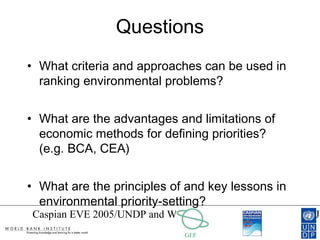This document discusses approaches for setting environmental priorities and management. It explains that in situations with limited information, qualitative ranking is necessary. Economic methods like cost-benefit analysis (CBA) and cost-effectiveness analysis (CEA) are most accurate but require valuations that are difficult. The document provides examples of applying multi-criteria analysis and expert judgment to prioritization in Nigeria. It also outlines challenges with economic valuation and benefit-cost analysis, like valuing human life and accounting for future generations.
























